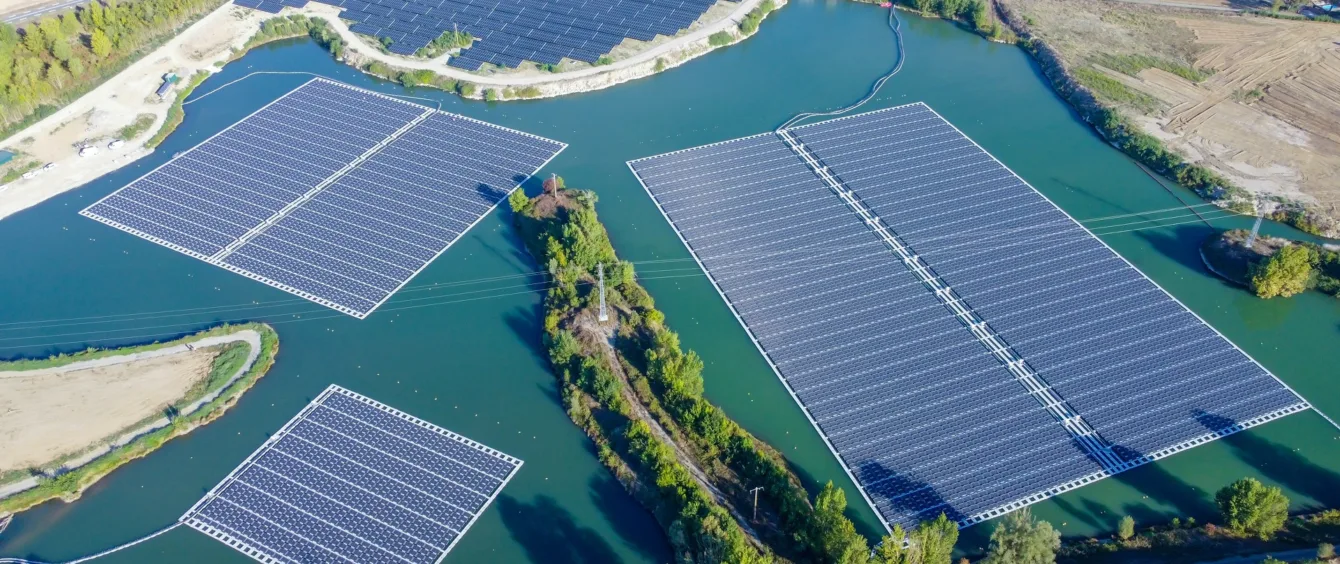Photovoltaic expansion set new records in 2022. According to the Market Master Data Register (Link in German), solar capacity additions in Germany totalled 7.18 gigawatts (GW). Only 0.026 percent is located on bodies of water although floating PV systems are very promising and harbour substantial potential.
Percentage shares of PV installations
1 Jan 2022 to 24 Apr 2023, source: Market Master Data RegisterThe potential of floating PV systems
Whereas ground-mounted solar arrays use a lot of space, floating modules can be set up in unused ocean waters off the coast. Moreover, they hold the promise of higher yields as the water cools the solar cells naturally, thus increasing module efficiency. In addition, floating PV systems reduce evaporation and there are indications of them curbing algae growth. Besides lakes and ponds, candidate locations also include flooded opencast mines and gravel pits. However, investment costs still clearly exceed those of onshore solar farms due to technical requirements. For instance, cables and modules installed in the vicinity of water and power components must be fitted with special insulation. The en:former presents some innovative approaches to overcoming these hurdles.
Companies are already investing in floating technology the world over. The solar modules are usually mounted on buoys that are linked to each other using flexible connections. This makes them very agile in adapting to water movements. Anchors in the water bed or shore stabilise the system while adapting to changes in water level, ensuring that floating PV systems always maintain their position in the desired orientation. Solar power generated is transmitted to the mainland via (under)water cables.
Daisy-chained floating systems
Technology specialist Zimmermann PV-Stahlbau GmbH has developed a novel substructure for floating PV systems. Instead of affixing every module to a float, the partners install twelve modules on a ‘boat’ consisting of four floats and a steel structure. These ‘solar boats’ are then connected to each other, making the system extremely stable, while enabling it to adapt to water movements. This allegedly ensures that the modules maintain a very good orientation towards the sun.
In addition to in-house engineering of the support, the companies also worked on a proprietary solution for cable guides and the transformer station. The switching concept encompasses a floating transformer station that does not occupy any additional room on the mainland. Since the solar power is transformed to medium voltage at sea, only a strong medium-voltage cable is required to transmit the solar energy to an onshore connection.
Construction of the floating PV systems is also performed according to a proprietary ‘daisy chain’ principle. First the solar boats are assembled onshore and connected in series. Then they are gradually let out to water until a complete chain of solar boats of the desired length floats on the body of water. This is followed by a motorboat dragging them to the location at which the rest of the system is assembled. This procedure should enable fairly fast installation.
Floating PV inspired by animal kingdom
Another innovative approach to floating PV has been taken by engineering firm Schlaich Bergermann Partner (sbp). The company claims to have developed the first floating system optimised for bifacial modules, making the technology more affordable, higher-yielding and safer. The system does completely without interlinked buoys to which solar panels are mounted. Instead, the modules are placed on membranous tubes with a length of 40 metres and a thickness of 80 centimetres, which are not inflated until onsite installation.
This enables very simple, space-saving transport. Furthermore, the system’s shape provides it with better protection from damage caused by waves than a rigid system as the air pressure in the tubes can be adjusted by integrated pumps to suit prevailing weather conditions. The stronger the wind, the more air is pumped into the tubes, as a rigid system confers better protection in such circumstances, explains sbp.
When wind speeds drop, air pressure in the tubes is lowered to protect the material. An onboard weather station monitors wind speed and movement and when necessary, the system automatically swells up like a blowfish. This explains the name ‘Gömbhal’ given to this technology, which is Hungarian for ‘blowfish.’
Another feature unique to the approach is that beneath the modules lies a bright membrane layer which reflects 60 percent of the sunrays and acts as a load-bearing structural member. This enables the bifacial modules to make use of both direct irradiation on the front as well as of indirect light on the back to generate electricity.
A first 50-kilowatt prototype has been floating on water in Gyor, Hungary, since the middle of October 2021. The developers are using this prototype to collect data to deepen their knowledge of the system’s energy yield and structural behaviour.
Floating solar on the rise
These and further innovative approaches can help unleash the enormous potential possessed by floating solar systems. According to Fraunhofer ISE, the surfaces of artificial bodies of water in Germany alone technically have the potential to produce 44 GW of power. If, to boot, investment costs drop as systems grow in size and the technologies become more widespread, both of which experts predict will happen, then nothing will stand in the way of a floating PV breakthrough.
